It's now past two years since SARS-CoV-2 (Covid-19) spread beyond China and became a pandemic.
From the outset, I've covered aspects of the pandemic on this website, beginning with Love in the time of Coronavirus back in March 2020, so the passing of the pandemic's second birthday seemed an appropriate time to review what we've learnt.
The positive news is that: Covid-19 has been far less deadly than the 1918-20 "Spanish Influenza' pandemic.
This relative success in limiting the number of deaths this time round is entirely due to modern science.
Although historians disagree over the numbers, all agree that the Spanish Influenza pandemic killed a great number. The lowest estimate is 17 million worldwide, while another puts it at between 24.7 and 39.3 million. Most, including the National Museum of Australia and Wikipedia, tell us that over 50 million people died worldwide. This was when the population of the world was 1.9 billion, less than a quarter of that it is today. However, most historians do agree that that virus did not originate in Spain but first crossed to a human in the United States originally from a waterbird (it was H1N1), then possibly, via a pig. The earliest documented case was March 1918 in Kansas. It was carried into the trenches of the Great War by one or more American 'Doughboys', from whence it spread across the world as the war ended. As Dorothy opined: 'Toto, I've a feeling we're not in Kansas anymore.'
In the early 20th century, vaccine development was by trial and error. Although bacteria could be seen using a powerful, optical-microscope, virions (virus particles) were invisible and could only be inferred to exist, like atoms 50 years ago. As a result, attempts to produce a vaccine in the 1920's targeted suspicious bacteria and were totally ineffective against the influenza, as were many attempted and folk-treatments - perhaps injecting disinfectant? No, no one would be that stupid!
Masks and social distancing provided the only effective mitigation until natural (herd) immunity stopped the spread.
Unlike that, most deadly, to date, of all viruses, this virus certainly originated in China.
The advent of the present, nCoV-2 (Covid-19), pandemic:
|
In December 2019 a Chinese doctor noticed patients suffering from a viral disease circulating in the wet markets in the City of Wuhan and initially thought it was a fresh outbreak of SARS (severe acute respiratory syndrome). As a result the markets were closed on January 1 2020. By January 5 SARS was ruled out. On January 7 Chinese researchers warned the WHO (World Health Organisation) that they had identified a new virus, named 2019-nCoV, and the WHO immediately warned relevant health authorities around the World. In addition, the Chinese had provided the full genome of the virus to the world's principal reference laboratories including: the US-CDC's Respiratory Viruses Diagnostic Laboratory in Atlanta; the Japanese Nagasaki Institute of Tropical Medicine and the Australian Infectious Diseases Reference Laboratory in Melbourne. Using the Chinese genome information, the US Center for Disease Control and Prevention (CDC) was able to confirm the first case in a Seattle hospital on January 21. The US citizen had recently returned from Wuhan. US doctors and scientists sounded the alarm and called for the immediate quarantine of travellers from China. This was actioned in Seattle but ignored by Washington. On January 23 the cities of Wuhan, Xiantao and Chibi in Hubei province were placed under effective quarantine, as air and rail departures were suspended. By the end of the week, more areas were placed under lockdown, affecting a total of 56 million Chinese people. This was well publicised across the world, with scenes of doors being locked and even welded shut. It was also reported, with overt condemnation, that China: "has used drones equipped with speakers to force citizens to wear face masks and had shut down 16 cities across the country and... China’s railway operator is using 'big data' to track down passengers who were in the same carriage as those who contracted the virus." On January 25, in Australia a man, who had returned from Wuhan to Victoria, tested positive to SARS-CoV-2. The same day (the 25th) President Trump tweeted (account suspended): China has been working very hard to contain the Coronavirus. The United States greatly appreciates their efforts and transparency. It will all work out well. In particular, on behalf of the American People, I want to thank President Xi! The following week (on Jan 31) amid, growing concerns about the draconian nature of the Chinese lock-down, WHO director general, Dr Tedros Adhanom Ghebreyesus tweeted: "The speed with which #China detected the outbreak, isolated the virus, sequenced the genome and shared it with WHO and the world are very impressive. So is China’s commitment to transparency and to supporting other countries." Yet media outlets in the West continued to condemn the Chinese actions. For example, Frances Eve from Chinese Human Rights Defenders who wrote, in The Guardian (on Feb 2), that China's reaction to the coronavirus outbreak violates human rights and that: "The WHO should abide by its own human rights principles and demand the Chinese government end its censorship and police suppression surrounding the coronavirus outbreak." By this time cases of the novel coronavirus had been identified in a dozen countries. In response to the obvious danger Australia closed its borders to China (on February 2) and the Prime Minister, Scott Morrison, announced Australia’s travel advice had been raised to level four – “do not travel” as the number of deaths worldwide rose to 260 and the estimated number of people infected worldwide was reported to be around 12,000 (a significant underestimate). Australian citizens, permanent residents and their immediate family, arriving out of mainland China (not just from the Hubei province) were immediately required to self-isolate for a period of 14 days. At that stage Australia had identified only 12 people who were infected and placed them in isolation. There were no deaths. Yet it was soon evident that Iran and Italy had a serious problem and the travel restrictions were extended first to Iran and then to other 'hot spots'. The Chinese Government initially objected to Australia's border closures that impacted many students. Yet these combined with very strict quarantine for travellers (under guard) turned out to be quite effective in supressing it's spread with outbreaks, all due to quarantine breaches, generally eliminated by comprehensive contact tracing and enforced isolation. Meanwhile in the US, President Trump refused to act, dismissing the virus as trivial, before embarking on a campaign of obfuscation, misinformation and inaction for the remainder of his term in office. As a consequence of his inactions and those of other national leaders like; the British Prime Minister, Boris Johnson, a viral outbreak in China, that was soon brought under control there, became a worldwide pandemic. |
As the two years passed at least six million had died. Yet, there have been distinctly different experiences in different countries, largely depending upon the degree to which governments have been prepared to sacrifice lives in the hope of maintaining economic activity; or minimising government expenditure; or containing civil disobedience; or avoiding electoral defeat.
The following table comes from Our World in Data (second birthday records - selected examples only)
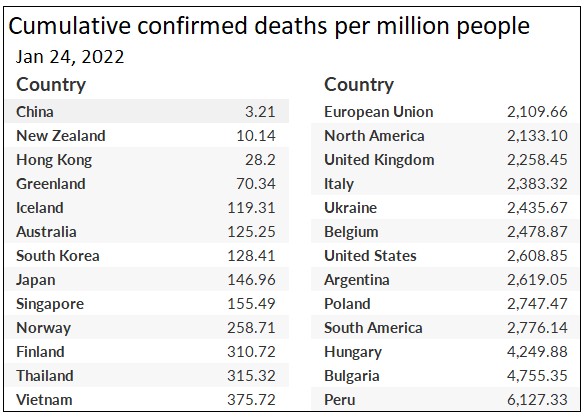 The left-hand side are countries that have managed to minimise deaths,
The left-hand side are countries that have managed to minimise deaths,
while those on the right are countries and regions that have not.
Clearly it helps to be an island. And yet Canada has a third of the death rate of the United States;
while Norway and Finland have a fifth of Sweden's.
Perhaps they have a more cohesive and therefore cooperative populous?
Nevertheless, worldwide the Covid-19 pandemic has caused economic chaos everywhere, principally through disruptions to commerce, travel and related services.
Many jobs have been lost. Government assistance to shore-up the various economies increased debt and deficit spending that will have on-going repercussions for years to come.
As already indicated the saviour has been modern science and in particular vaccination.
Vaccination
|
The big difference between this pandemic and the Spanish Influenza has been effective vaccination. In 1931 German Physicists, Ernst Ruska and Max Knoll, developed the first electron microscope, at the University of Berlin, and, in 1935, a virion was photographed for the first time. Yet, it was not until 1955 that the full structure of the tobacco mosaic virus was first elucidated, by the ground-breaking x-ray crystallographer, Rosalind Franklin, who's work also helped reveal the double helix structure of DNA. From that time on, cell-biology and bio-technology moved forward in leaps and bounds. So that in 2020 several dozen independent teams around the world set to work. The process of highly specific vaccine development, based on a detailed molecular map of the virus, that two decades ago took decades to accomplish, was foreshortened to a few months. Thus, ten, tested, safe and efficacious, vaccines against the virus, employing a range of technologies, have already been deployed in many countries. And many of these teams are continuing to work against the rise of the inevitable virus variants: COVID-19 vaccines, and the technologies employed, as at January 2022
* Available in Australia |
If you know little of biology, but are interested to know more, you might choose to read: 'The Chemistry of Life' on this website. It's a simplified version, originally written for my children, who have long outgrown it - now it's for the grandchildren.
Deaths in Australia
In Australia and a number of other countries prompt border closures: international, interstate; intercity; and occasionally intracity; with the closure of social venues; imposed social distancing; mask mandates; and occasional harsher lockdowns; kept the virus largely at bay so that in many places, for months on end, life went on largely as normal, while looking forward to the availability of an effective vaccine.
A contact tracing app was developed and was widely distributed but proved ineffectual. This was soon replaced by compulsory QR code (or manual) registration, before entry to indoor venues like: bars and cinemas; sporting venues and all retailers.
But as the second year approached the Australian National Cabinet (the intergovernmental decision-making forum composed of the prime minister and state and territory premiers and chief ministers - set up to manage the pandemic) decided that: with over 90% of the adult population vaccinated, it was time to end economically damaging lock-downs.
In doing so, they have accepted that this will inevitably result in an increasing number of pandemic deaths.
So now the numbers are rising the media have a new news story: 'If it bleeds - it leads'
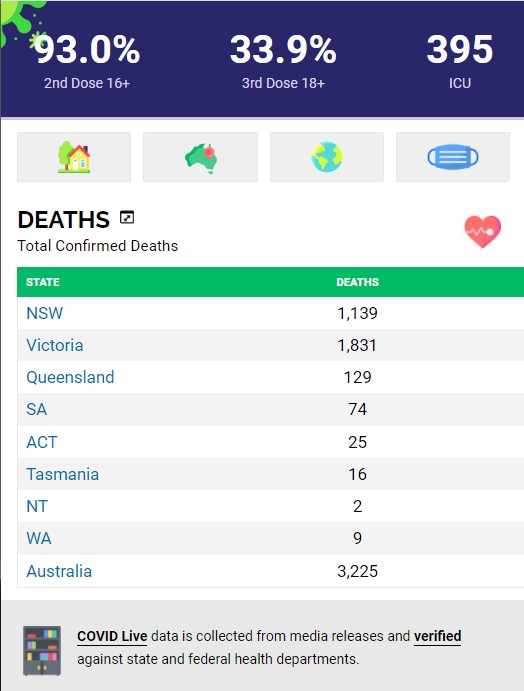 https://covidlive.com.au/report/deaths
https://covidlive.com.au/report/deaths
Covid-deaths are in the news in Australia, so I went to the Australian Bureau of Statistics (ABS) website for some perspective.
In a typical year 150 to 170 thousand people die Australia wide. The top five leading causes of death are Ischaemic heart disease, Dementia including Alzheimer's disease, Cerebrovascular diseases, Lung cancer and Chronic lower respiratory diseases.
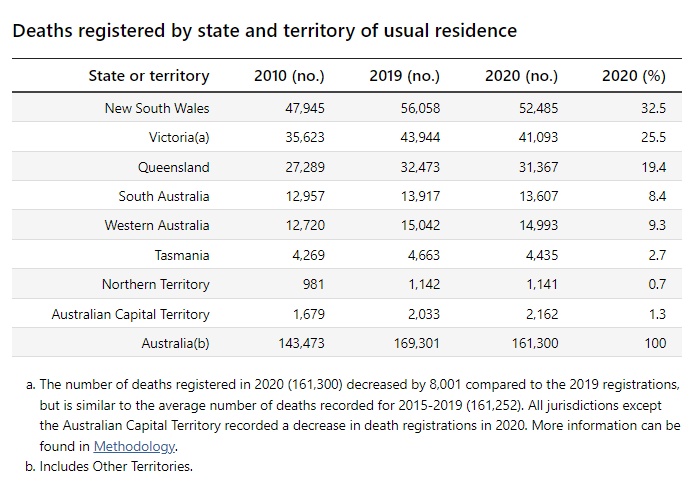
Covid-19 was well down the list. In 2020 it was the 38th most common. And of the Covid-19 deaths, around three quarters of those who died also suffered from other life-threatening conditions, in particular old age.
Deaths (all causes) by age and sex
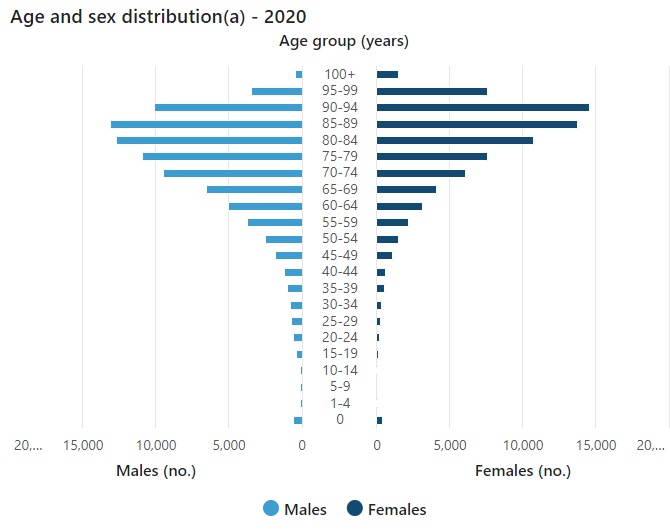
According to the ABS he unvaccinated CFR (case fatality rate) in Australia (that is, of those who catch the disease what percentage can be expected to die) for Covid-19 as of 31 July 2021 (Delta variant) was 2.7%. But as the chart below indicates CFR rises dramatically with age.
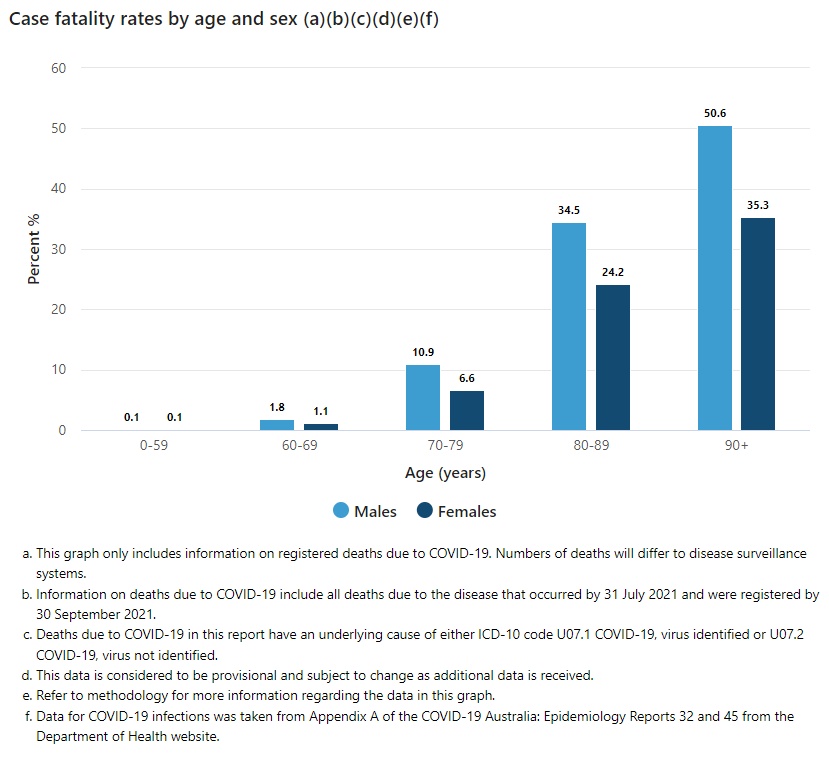
Thus, a still-unvaccinated man over 80 who catches Covid-19 has a better than 30% chance of dying. Buy a revolver - Russian-Roulette (CFR 17%) is a much better bet than remaining unvaccinated - and quicker.
Back in 1918 the Spanish Influenza that had an estimated CFR of around 2.5% (Taubenberger and Morens) so without vaccination we could expect a similar number of deaths, until the virus played itself out (through a combination of herd immunity and evolutionary pressure). In some ways the Spanish Influenza was worse than Covid-19. It impacted young adults to a much greater degree and back then there were a smaller percentage of people over the age of 60 to be killed (they were dead already). Within a few months in 1919 an estimated 15,000 Australians had died of Influenza.
Australia's total population was just 5.3 million.
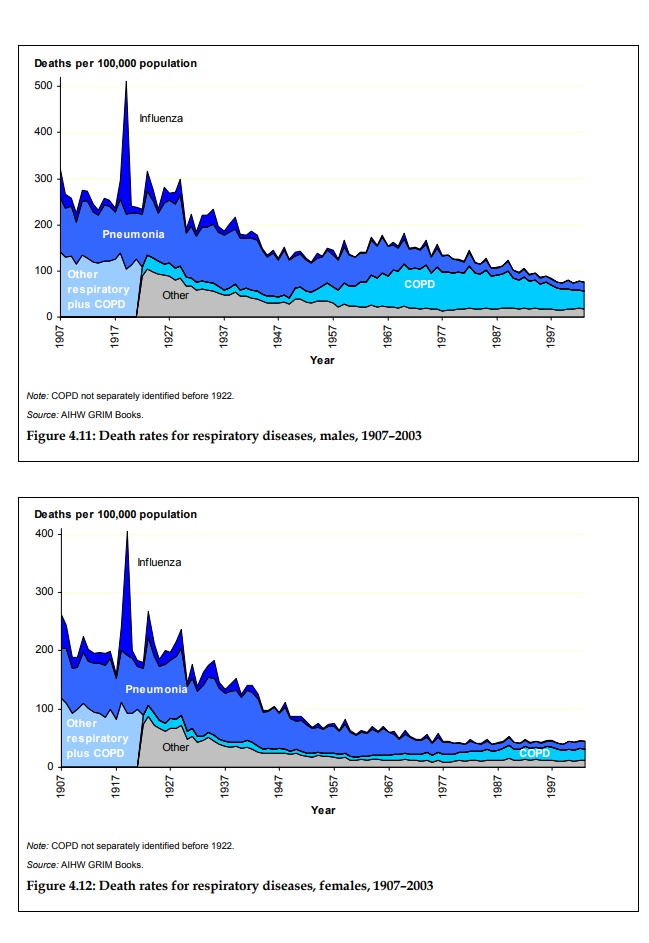
So, overall, will Covid-19 show up as a big spike in our deathrate when historians look back? The 1918-19 influenza pandemic certainly did.
This one will certainly show up as another big spike in the US and UK.
Well, no. When Victoria had their initial high deathrate, prior widespread vaccination, the ABS found that deaths in Victoria were lower than the long-term trend. The consequent hard lockdowns did as much to reduce other diseases that are potentially as deadly to the elderly, like influenza.
Well done, Victoria.
As the ABS reported for the whole of Australia in 2020:
"There was a 23.9% decrease in the age-standardised death rate from respiratory diseases.
Influenza and pneumonia mortality had the highest proportional rate decrease of all respiratory diseases with a drop of 45.8% from 2019.
There were 55 people who died from influenza. This compares to 1,080 in 2019.
Pneumonia is also a common terminal cause of death, especially for older people who have long term chronic conditions. There was a decrease of more than 20% in influenza and pneumonia as an associated cause of death (where it was not the underlying cause of death).
The decrease in the respiratory disease death rate from 2019 is the largest recorded over the last ten years."
Thus, pre-Covid, in New South Wales, an average of around 140 people died each day. Since 'opening-up' Covid-19 deaths are running at 32 per day (7-day average) but some of these would have died in any case due to underlying complications and others who may have died of respiratory disease may be hanging on. While any death is a tragedy for friends and family, at this stage it seems that the death rate is manageable, within the normally expected range.
So, historians will note that: in the first two years, Australia largely avoided the worst impact on life expectancy of the Covid-19 pandemic.
On the pandemic's second birthday, Australian society could, yet again, be congratulated on its cohesiveness, purpose and common sense in adversity. And perhaps our leaders, when they take advice from our Public Servants, aren't too bad after all?
Yet, we can have little sympathy for those younger ones who still refuse to get a couple of relatively harmless injections, putting themselves and others at risk, and end up in ICU or with long-term ill effects.
But the social and economic impacts of lock-downs and border closures and financial assistance were both immediate and long-term.
So, let's now concentrate on getting the economy up and running again to reduce the present burden's impact on future generations.
As I suggested at the outset: Love in the time of Coronavirus, after vaccination became the norm, herd immunity has become our best strategy: get vaccinated or get infected (and suffer the consequences). We no longer lockdown for the annual flue, nor should we.

